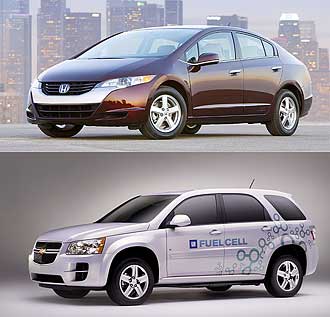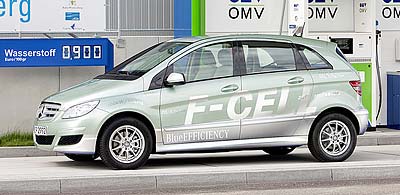Hydrogen Fuel Cell Cars
Hydrogen fuel cell cars are quite simply the future of the automotive industry. These vehicles are electric vehicles that use a hydrogen fuel cell for power instead of a battery pack.
|
Most of the major automobile manufacturers today have one or more hydrogen fuel cell cars in their lineup of prototypes.
|
 |
Some, carmakers like Ford have both hydrogen fuel cell vehicles and H2ICE (hydrogen internal combustion engine) cars in their lineups.
Almost all of the H2 vehicles being shown today are built around a hydrogen PEM (proton exchange membrane) fuel cell (Volkswagen is one exception that has been experimenting with a solid oxide fuel cell).
A couple of the hydrogen fuel cell cars that have made headlines of the past couple of years are the Honda FCX Clarity and the Chevy Equinox Fuel Cell. The Honda Clarity has won numerous awards including the 2009 World Green Car award and the 2009 Grove Medal.
The Honda Clarity is also part of a pilot program where it is being leased to select consumers for $600 per month over two years time. Up to 200 Honda FCX Clarity’s are to be leased and the results studied by the company’s engineers.
The Chevy Equinox Fuel Cell, on the other hand, is part of the GM Project Driveway Program. Project Driveway is putting the Chevy Equinox Fuel Cell vehicle in the hands of over 200 drivers for 2 or 3 month periods for test driving.
The drivers of these two fuel cell cars have to be at least in the Los Angeles area where most of the public hydrogen fueling stations in the U. S. are currently located, though Project Driveway members can also be in New York or Washington DC which also have several H2 fueling stations at their disposal.
GM and Honda, Daimler …
Besides GM and Honda, Daimler also has a large fleet of hydrogen fuel cell cars and probably can still claim the title of having the most FCVs (fuel cell vehicles) on the road. Most of the Daimler hydrogen fuel cell cars are being used in Germany and other European nations, except for a few that turn up occasionally at auto shows in the U. S.
Hydrogen fuel cell cars are considered to be zero emission vehicles (ZEV) because they have no tailpipe emissions. Some will argue that since most hydrogen fuel is produced from natural gas that there are indeed “well-to-wheel” emissions.
But, when hydrogen fuel is produced using renewable energy such as wind, solar, geothermal, or hydro-electric, it has zero emissions well-to-wheel. When hydrogen is produced for fuel cells using renewable energy it is done so by passing an electrical current through water (H2O) and splitting it into H2 and O.
The hydrogen is then compressed to 5,000 psi or 10,000 psi and eventually pumped into a fuel cell car’s specially constructed tank. From there, the hydrogen from the tank plus oxygen in the ambient air passes through the fuel cell. This creates an electrical current that turns one or more electric motors that turn the wheels of the car.
Battery Electric Vehicles?
In the past couple of years and especially with the Obama administration, many people see battery electric vehicles instead of hydrogen fuel cell cars as the near term solution to zero emissions, reducing greenhouse gases that contribute to global warming and lessening dependence upon foreign fossil fuels.
Battery electric car advocates cite the lack of hydrogen refueling infrastructure as the major hurdle in rolling out fuel cells cars on a nationwide basis. And, they would be correct that the needed infrastructure is not yet in place to support a rollout of millions of hydrogen fuel cell cars.
What would help with the infrastructure shortcoming however is the advent of home hydrogen fueling stations. Companies such as Honda, ITM Power and Hydrogenics have at least prototype home hydrogen pumps that may be available soon.
|
One of the problems with having hydrogen fuel cell cars for everyday use is the “chicken or the egg” syndrome.
|
 |
Automakers don’t want to build thousands or millions of hydrogen fuel cell cars if the H2 fueling stations are not in place. The manufacturers of fueling stations and those who run them do not want to invest the money in them if there are only a handful of hydrogen fuel cell cars on the road.
It is because of this chicken-or-the-egg syndrome that the U. S. is trying to use the “hydrogen cluster” model to put fuel cell cars in the marketplace. This model uses high population areas such as Los Angeles and New York City, and rolls out fuel cell cars and hydrogen fueling stations concurrently.
In Germany, which is far smaller than the United States, there is an H2 Mobility plan in place. A consortium of companies and government entities are racing to put up H2 fueling stations throughout the country so that hydrogen fuel cell cars can be commercialized in that nation by the year 2015.
In summary, hydrogen fuel cell cars are still the future compared to current battery electric vehicles. Hydrogen fuel cell cars outperform battery electric vehicles on both range and refueling time. Though a huge hydrogen refueling infrastructure will need to be in place for fuel cell cars to take off, so will a huge recharging infrastructure need to be in place to accommodate electric cars.
But, this isn’t an either / or scenario. Both types of vehicles plus biofuel vehicles will be part of the automotive future for years to come. The goals are the same for all alternative fuel vehicles including reducing emissions, reducing global warming and reducing dependence upon foreign fossil fuels.
Written by Hydro Kevin Kantola